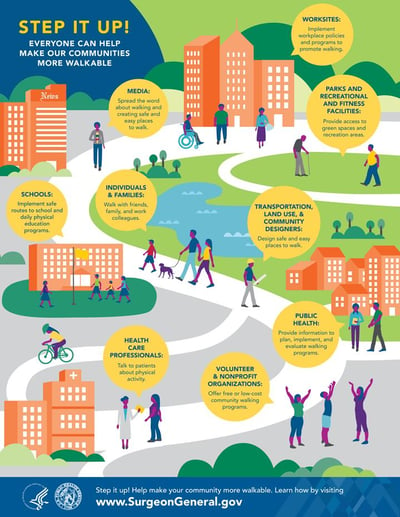US Surgeon General Calls on Americans to Walk More
 Twitter summary: @Surgeon_General issues call to action for Americans to #StepItUp and increase physical activity by walking.
Twitter summary: @Surgeon_General issues call to action for Americans to #StepItUp and increase physical activity by walking.
The inspiring US Surgeon General, Dr. Vivek Murthy recently issued a “Call to Action” for Americans to increase their physical activity by walking more, and for the nation to improve “walkability” of communities and neighborhoods. What does that mean? Make it safer and easier for people of all ages to walk, of course! The call to action, titled Step It Up!, highlights the numerous health benefits of physical activity, and explains why walking is a form of exercise that is well-positioned to address the public health crisis of obesity and diabetes. In 2012, only half of US adults reported levels of physical activity consistent with those recommended by national guidelines. In addition to personal walking goals, Step It Up! calls upon nearly every societal sector – such as transportation, media, and schools - and the nation as a whole to create a culture in which it’s easier and expected to get more physical activity. We love this collaborative approach – personal motivation is a crucial, but for many people external barriers to physical exercise (lack of parks/sidewalks to walk on, lack of physical education in schools, etc.) are equally critical to address.
Why is walking good for you? While walking is often perceived as not strenuous enough to have big health benefits, dozens of scientific studies suggest that walking is, in fact, significantly associated with better health. Some studies say walking can reduce the risk of heart disease by up to 30%. The best part is that it’s accessible and free!
For people with diabetes, walking can have added benefits to diabetes management. As our Senior Editor Adam Brown has previously discussed, walking can notably reduce blood sugars. Adam found that walking dropped his blood sugar by approximately 1 mg/dl per minute (e.g., -30 mg/dl in 30 minutes) and decreased his insulin needs. Kelly finds this all the time – whenever she walks with John, he always reminds her that her blood sugar will drop! Researchers have found that each additional 2,600 steps a person walks in a day (about a mile) is associated with a 0.2% lower A1c. As Adam has also discussed, wearing an activity tracker might be a helpful way to increase your steps.
For now, we encourage anyone interested to engage in this call to action on an individual basis. Here are a few to help you get started:
-
Go for post-meal walks with your friends and family (or with an audiobook, music, or podcast!)
-
Park in the farthest spot at the store or mall
-
If you ride the bus, get off a stop or two early and walk the rest of the way
-
Avoid elevators, escalators, and moving sidewalks
-
Pace when you’re talking on the phone, or if you need to think through an issue
-
Walk instead of driving, when possible
Join the conversation on Twitter and let the Surgeon General know how you’re getting your daily steps in with the hashtag #StepItUp!







